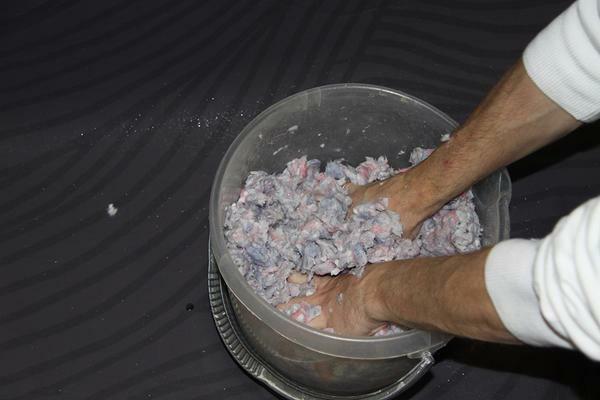Contents
- 1 Work order
- 1.1 Related materials
- 1.2 Sealing procedure for gypsum board
- 1.3 Final stage
- 1.4 Useful advices
The plasterboard sheet deserves particular popularity among the finishing materials. It is not only quickly mounted, but does not require a "wet" process, it allows you to create designs and forms of any complexity.
The only drawback that occurs when installing, sealing plasterboard joints.
If the sealing of gypsum board joints is performed with technological disruptions, over time, cracks appear on the joints. And the question arises, and how to properly seal the seams in the drywall, which tool to use and related materials.
Order of work
Puttying of gypsum board joints is made on structures, walls, walls already assembled from plasterboard sheets.
But without a properly selected tool, accompanying materials, you can not do a good job.
Remember! It is recommended to put up the joints of plasterboard sheets at room temperature above + 10ºC and humidity of air not less than 60%.
For mixing the solution, it is better to use a small container and small volumes.
Remember! Mixing of putty mortar with a mixer is recommended at the lowest possible speed. At high revs a large amount of air gets into the solution, which increases the porosity of the resulting solution, and therefore, reduces its strength characteristics. When mixing manually the quality of the mixture is higher, but the use of power tools increases the efficiency and productivity of the work.
Any container can be used to mix the solution, but it is best to use a plastic bucket or special trough. The main thing is that the container is convenient to wash after using the mixture.

Putty joints of plasterboard are made with spatulas of various widths. The minimum width of the spatula is 100 mm. For large areas, it is advisable to use spatulas with a width of 350 mm.
For cleaning of putty joints it is recommended to use fine-grained sandpaper, grinding mesh. Use grinding mesh more convenient, but its cost is much higher nazhdachki. You will also need a construction knife.
Accompanying materials
It is necessary to stock up with a deep penetration primer, a putty for gypsum board joints reinforced with a tape.
We have repeatedly pointed out that you should not save on quality materials. The best auxiliary materials for sealing joints of gypsum boards are Knauf related products, which developed the technology of using plasterboard sheets.
For sealing of gypsum board joints it is recommended to use a dry putty mixture Knauf-Uniflot, the basis of which is a gypsum binder with polymeric
additives or Fugenfühle.
There are other no less qualitative auxiliary materials, for example, putty mix fugenfuhler. One should always remember that all auxiliary materials should be from the manufacturer whose drywall you bought.
Remember! Do not save on quality finishing materials. Proverb: "Miserly pays twice" is fair to the full.
Sealing procedure for gypsum board
Surface preparation for filler
Stage I
Work should begin with cleaning the surface of the docking units.
Slice the mortar with a wide spatula, remove the dust with a vacuum cleaner. While holding the spatula at an angle of 30º, pass through the joints of the sheets, removing any irregularities.
Screw in the protruding hats of the screws, drowning them by 1 mm.
With a damp cloth, remove dust from the surface.
Gypsum boards have factory and edging edges. The factory edge does not require preparation, but for the edging edge at the ends you must remove the chamfer.
Stage II

For chamfering, a special tool called the edge plane is used on the trimming edge. It provides a chamfer at the ends of the edging at an angle of 22, 5º.
Do not attempt to chamfer with a construction knife.
Presence of a chamfer greatly facilitates the laying of a layer of putty, which increases the strength of the structure.

Stage III
The place of docking must be primed. Primer is applied with a roller or a wide flute brush. Application of the roller improves the process of rubbing the primer, rather than using a brush for these purposes.
Allow time for complete drying of the primer coat. It's better if you start shpatlevaniyu in 24 hours.
We prepare the putty mix
And how to cover the joints of plasterboard?
A special putty mix is prepared strictly according to the enclosed instructions, without any improvisations or deviations. For sealing seams gipsokartonnyh sheets are issued special mixtures. They are gray or beige in color. Color does not affect the quality of the solution.
So what kind of filler to seal the joints of plasterboard?
It is preferable to use Knauf blends specially developed for this technology. We recommend the use of dry mixes Uniflot or Fügen Fuhler.
But there are other high quality analogues produced by different manufacturers.
The consistency of the solution should resemble the density of non-liquid sour cream.
Remember! Cooking should be as much solution as you can work out during the life of the solution, it's 20 minutes.
Stage IV
Using a putty knife, the mixture is evenly applied to the seams, spread out with a wide spatula. Simultaneously shpaklyuyutsya hats self-tapping screws.
The puttying layer on the joints with the edging edge is thinner than the layer at the joints with the factory edge.
Stage V

While the putty is wet, a special reinforcing tape is applied to the seams and is smoothed with a wide spatula. The bonding of the reinforcing tape increases the strength of the seam, and does not subsequently give rise to cracks.
It is recommended to use Kurt reinforcing paper tape or its analogs. The tape has high strength and protects from cracking.
Reinforcing tape Kurt perfectly passes air, does not stretch and easily absorbs moisture. After drying the tape does not bubble, does not cause the appearance of cracks. From analogous Kurt tape we recommend
It is not recommended to use paper tape when sealing gypsum board seams. A tape made of paper does not let in air, does not absorb moisture. After drying, the paper tape bubbles, raising the layer of putty.
Well, it's completely useless self-adhesive mesh tape, so beloved by Russian painters. It is easily stretched and does not have strength.
At the finish, the final grouting of the gypsum board joints is carried out.
Final stage
After drying, the joint is cleaned with a trowel if necessary, sanded with sandpaper. The entire surface is covered with a layer of soil.
You noticed that the sealing of gypsum cardboard joints with your own hands is not difficult and can be performed independently at home even by a novice master.
But in order to answer the question of how to seal joints between plasterboard, it is recommended to view the training video.
Conclusions:
- - for obtaining a high quality docking unit of drywall sheets, the joined edges must have chamfers, factory or with a planer;
- - chamfers must be necessarily smeared with deep penetration soil;
- - it is recommended to use Kurt reinforcing paper tape as an armature or its analogs;
- - as a putty it is recommended to use special mixtures for sealing joints of gypsum boards.
- Video on sealing joints in plasterboard will help you understand the intricacies of work.


